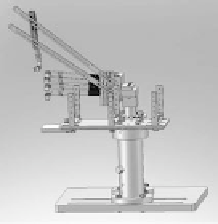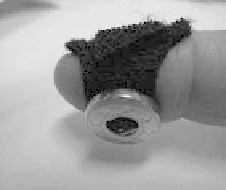Biomedical Engineering Reference
In-Depth Information
B
A
a)
b)
Figure 6.4
Thumb actuator configuration (a) palmar grasp (b) pinch.
180
a)
b)
c)
Figure 6.5
Connecting fingers using button connector (a) ring wrap around finger (b)
metal bar with pivot mount (c) finger connect to metal bar.
front of the metal bar can rotate 180 degrees to allow finger to rotate along the tip
of the bar when it is hand opening or hand grasp.
6.2.2.3 Position and Force Feedbacks
Each linear actuator is equipped with a linear slide potentiometer (ALPS model
no. STRSA0N12S) which is used to measure the stroke extension of the actuator
and hence this position feedback can be used to keep track of the finger position
during training.
The metal bar of each actuator has a force transducer installed to measure the
force applied by the finger. A pair of 5 mm foil strain gauges are installed in
the cavity to measure the force during finger flexion and extension movements.
Calibration is required to convert the feedback voltage into Newton (N). Multiple
sand bags of 250 g are used to measure force up to 5 kg in both force directions
(flexion and extension). Since the strain gauge has a good linearity, force beyond
5 kg or 49 N can still be measured.
6.3 EXPERIMENT PROCEDURE
When using the hand rehabilitation robot, subjects were asked to put their arms on
the arm holder at a horizontal level. Wrist angle was fixed at zero degree to assure
that gravity force would not interfere with the actual performance and hence the



























